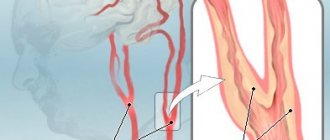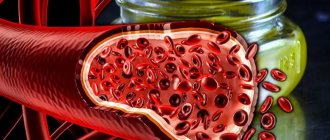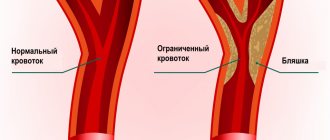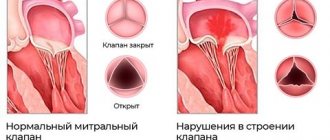Symptoms
Signs of atherosclerosis do not appear immediately. The first stages of atherosclerosis of the heart vessels are asymptomatic. The disease makes itself felt when the coronary artery becomes so blocked that it no longer supplies the heart with enough blood. A blood clot can completely block blood flow, causing a heart attack.
The main sign of severe atherosclerosis is burning or pressing pain in the chest, which initially bothers you during physical activity or in a stressful situation. This syndrome is called cardiac angina. Pain can be felt behind the sternum, radiating to the left arm, shoulder girdle and jaw. In addition to the feeling of constriction, a person is worried about shortness of breath, weakness, and excessive sweating. All these are signs of coronary heart disease (CHD). The nature of the load under which attacks occur varies. At later stages of development of coronary artery disease, the pain syndrome is no longer determined by any reasons; in this case, they speak of a type of angina called resting angina.
Who is at risk
Every person, regardless of gender and age, can develop atherosclerosis of the coronary arteries. This is facilitated by many factors, ranging from social reasons to poor ecology. Guidelines for assessing risk factors for the development of cardiovascular diseases, developed on the basis of many years of research in the field of cardiology, highlight the following indicators:
- Men aged 50-55 years;
- Difficult working conditions due to professional activities;
- Hereditary heart pathologies;
- Obesity;
- Smoking, including passive smoking;
- Psychological disorders – stress, depression, depression;
- Thyroid diseases;
- Poor nutrition, the definition includes fried, fatty, sweet and flour foods, fast food.
A systemic risk assessment for the next 10 years can be made independently using the well-known SCORE (Systemic COronary Risk Evaluation) scale proposed by American cardiologists. The modern pace and rules of life put every second person at risk. Therefore, it is difficult to find a better prevention of atherosclerosis of the heart vessels than regular preventive examinations. At the slightest suspicion, it is better to consult a cardiologist and adjust your lifestyle than to undergo long-term treatment, which does not always have a positive outcome.
Research and diagnostics
If you notice symptoms of atherosclerosis or in case of a hereditary predisposition, we recommend making an appointment with a cardiologist for a consultation and checking your blood cholesterol levels. Depending on the results of the examination, the doctor prescribes the following diagnostic tests:
- Lab tests. The patient will be asked to take a blood test to check their sugar and cholesterol levels. 9-12 hours before the procedure, do not eat or drink anything (except water).
- ECG. The examination helps to identify abnormalities in the functioning of the heart and previous heart attacks. If you complain of pain during physical activity, your doctor will prescribe a stress electrocardiogram (bicycle ergometry and treadmill test).
- Stress test. This is monitoring of heart function during physical activity, which is exercise on an exercise bike or walking on a treadmill. While you exercise, your doctor will take readings of your blood pressure and heart rate. If it is not possible to take the test in a standard way, you will be tested using a special medication, the effect of which simulates physical stress on the heart.
- Coronary angiography. With the help of this examination, it is possible to understand which coronary vessels are affected by atherosclerosis. The doctor injects a contrast agent through a catheter passed through an artery in the leg or arm to the heart. While the vessels are filled with it, the X-ray unit operates. An image of the coronary arteries is displayed on the monitor, and the specialist marks the affected areas. Watch the video of coronary angiography by following the link.
- Additional research. Your doctor will recommend a CT or MRI scan, as well as an ultrasound, to determine if you have an aneurysm and calcium deposits in your arterial walls.
Atherosclerotic cardiosclerosis
Structural heart diseases, accompanied by impaired pumping function of the organ, are a common cause of death. Particularly dangerous is the lack of blood supply to the muscular lining of the heart, which often leads to the development of diseases such as coronary artery disease, atherosclerotic cardiosclerosis and myocardial infarction. In this case, treatment of the heart vessels is a priority. We should not forget that atherosclerotic cardiosclerosis is a progressive pathology.
Atherosclerotic heart disease
In the medical literature, atherosclerotic cardiosclerosis is a structural pathology characterized by the gradual replacement of the muscular lining of the heart with connective tissue cells against the background of progressive hypoxia. There are many causes of this pathology, but atherosclerotic lesions of the coronary arteries are the main etiological factor. Atherosclerotic cardiosclerosis can cause dangerous complications such as heart failure and heart attack.
The human heart is a powerful four-chambered muscular pump that supplies all cells of the body with nutrients and oxygen. The constant movement of blood in the vessels is supported by rhythmic contractions of the myocardium. The muscular lining of the heart also requires a constant flow of blood, since cardiomyocytes are not able to accumulate enough oxygen to function autonomously. Even a slight decrease in blood flow to the myocardium leads to progressive changes and disruption of pumping function. The longer ischemia develops, the more dangerous the consequences of such a disease.
Atherosclerotic cardiosclerosis is not always considered an independent disease. As a rule, this is a consequence of a long course of coronary heart disease (CHD), inflammatory and autoimmune processes. However, replacement of normal cardiomyocytes by dysfunctional scar tissue is a major cause of myocardial dysfunction. To eliminate this pathology, first of all, treatment of the root cause of organ hypoxia is required.
8
24/7
Possible reasons
The main factor contributing to the development of cardiosclerosis is insufficient oxygen supply (hypoxia) to the muscle cells of the heart. Secondary factors include inflammatory and infectious processes, autoimmune diseases and organic myocardial damage. Under hypoxic conditions, myocardial cells first change and stop contracting, and then are destroyed.
Main reasons:
- Atherosclerosis of blood vessels is the gradual growth of fatty plaques on the inner walls of the arteries, causing a narrowing of the lumen of the vessel and a decrease in blood flow. Plaques form due to blood lipid imbalance, poor nutrition, vascular damage and other factors. With atherosclerotic disease of the coronary arteries that supply the heart, myocardial hypoxia develops.
- Coronary heart disease is a consequence of narrowing of the blood vessels of the heart. This may be atherosclerosis, dysregulation of tone, or a congenital anatomical defect of the arteries. IHD is a progressive disease that causes gradual replacement of cardiomyocytes with connective tissue. Atherosclerotic cardiosclerosis, in which angina pectoris occurs quite often, has a common mechanism of occurrence with ischemic heart disease.
- Coronary artery thrombosis is a partial or complete blockage of blood vessels.
- A heart attack is a sudden cessation of blood supply to the heart, accompanied by focal or diffuse destruction of cardiomyocytes. Destroyed muscle cells are also replaced by connective tissue.
- Pathologies of connective tissue, characterized by excessive proliferation of fibroblasts or the appearance of abnormal proteins.
Doctors are not always able to identify the real cause of atherosclerotic myocardial disease in a patient. Pathology is often detected in late stages.
Risk factors
Atherosclerotic cardiosclerosis of the heart can progress even faster under the influence of negative factors that are not the direct cause of the disease. This may be an unhealthy lifestyle, primary disorders of the cardiovascular system and other phenomena.
The main risk factors include:
- Pathologies of the heart and blood vessels in a family history.
- High blood pressure.
- Obesity and sedentary lifestyle.
- The predominance of fatty foods in the diet.
- Blood lipid imbalance (high concentration of bad cholesterol).
- Diabetes.
- Kidney diseases.
- Smoking and alcoholism.
- Use of drugs that affect the heart.
The listed factors largely determine the mechanism of development of almost any pathology of the heart and blood vessels.
Symptoms and signs
Atherosclerotic cardiosclerosis, the causes of which are usually associated with primary diseases of the heart and blood vessels, can manifest with various symptoms. First of all, these are symptoms of ischemic heart disease, myocarditis, heart attack or any other factor in the development of cardiosclerotic disease. In this case, the process of replacing cardiomyocytes with connective tissue practically does not manifest itself until the patient experiences myocardial dysfunction.
8
24/7
Possible manifestations of the disease:
- Constant fatigue, especially during physical activity.
- Hesitant breathing.
- Dizziness and headache.
- Loss of consciousness.
- Cardiopalmus.
- Feeling of heaviness in the chest area.
- Chest pain (angina pectoris).
- Swelling of the lower extremities and abdominal cavity.
- Pulmonary edema.
- Insomnia.
- Anxiety and fear.
- Violation of the rhythm of heart activity.
Thus, atherosclerotic cardiosclerosis masks its symptoms under ischemic heart disease and other primary diseases. As a result, cardiosclerotic changes are detected already at the stage of severe complications.
Diagnostic methods
Most often, atherosclerotic cardiosclerosis is an incidental diagnostic finding during a cardiac examination for ischemia, atherosclerosis or other diseases. Patients consult a cardiologist with complaints of angina, exercise intolerance, dizziness and other symptoms. The doctor reviews your history for risk factors and performs a physical examination. During listening (auscultation) of the heart and general examination, objective signs of myocardial dysfunction are often detected. The diagnosis of atherosclerotic cardiosclerosis is made based on the results of instrumental and laboratory methods.
Additional research:
- Electrocardiography – registration of the bioelectrical activity of the heart. To do this, special sensors are placed on the patient’s body connected to a cardiogram recording device. Based on the test results, one can judge the presence of a structural pathology that prevents the normal propagation of an impulse in the myocardium.
- Echocardiography is the main imaging method in cardiology. The doctor uses a transducer that sends high-frequency sound waves into the heart to produce an image. Monitoring the heart's performance on a monitor in real time allows you to detect the focus of cardiosclerosis and assess the degree of pumping dysfunction.
- Angiography – visualization of blood vessels. As a rule, this method is used to diagnose coronary artery disease, heart attack and atherosclerosis. Before taking the image, the doctor injects a contrast agent intravenously to improve the accuracy of the study. Based on the results of coronary angiography, one can judge the cause of cardiomyocyte hypoxia.
- Stress test - obtaining a cardiogram during increased heart activity. This test is most often used to diagnose hidden arrhythmia and pumping dysfunction.
- Holter study – recording of a cardiogram on an electronic device of a portable device within 24-48 hours. Before the study, the patient is instructed to keep a diary of well-being to clarify the time of occurrence of the arrhythmia. This is the optimal method for searching for manifestations of myocardial dysfunction.
- Cardiac biopsy – removal of a section of heart tissue followed by histological examination.
- Blood test for lipid profile, hormones, minerals and heart attack indicator enzymes.
- Computed tomography and magnetic resonance imaging are methods for obtaining high-resolution images of the heart and blood vessels. The images are often used to plan surgery.
- Radionuclide study - visualization of the heart with the preliminary introduction of radioactive isotopes into the bloodstream. The results of the study demonstrate the effectiveness of blood supply to the myocardium.
The abundance of diagnostic methods is justified by the number of possible etiological factors. To treat the disease, the doctor also needs to assess the degree of cardiosclerosis.
Treatment and prevention
Treatment should be aimed at eliminating the root cause of the pathology, restoring myocardial function and preventing the development of dangerous complications. Surgical and medicinal correction methods are used.
Prescribed drugs:
- Beta blockers to lower blood pressure and eliminate arrhythmias.
- Calcium channel blockers to improve blood supply to the myocardium.
- Aldosterone inhibitor to lower blood pressure.
- Diuretics to improve hemodynamics.
- Cardiac glycosides, statins and other drugs necessary to treat the cause of the pathology.
Atherosclerotic cardiosclerosis can rarely be eliminated with medication, but medications prevent the progression of the disease and eliminate symptoms.
Surgical methods:
- Implantation of a pacemaker or defibrillator.
- Correction of the coronary arteries to improve blood flow.
- Surgery for structural heart pathologies.
Prevention methods are also important. Giving up bad habits and fatty foods, losing weight, moderate physical activity and timely treatment of primary pathologies of the cardiovascular system helps prevent the development of irreversible changes in the heart. If symptoms of myocardial dysfunction appear, it is recommended to consult a cardiologist for examination.
8
24/7
Treatment of atherosclerosis of heart vessels
The method of treating atherosclerosis of the heart vessels depends on the degree of vascular damage and the risks that the disease poses in each specific case. Often, to stop the development of the disease, it is enough to give up bad habits, start eating right and doing regular exercise. It is possible that medication or surgery will be needed.
Atherosclerosis is fought with:
- Cholesterol-lowering drugs. For example, fibrates and statins. They reduce the level of “bad” cholesterol—low-density lipoproteins—and increase “good” cholesterol—high-density lipoproteins. As a result, the process of fat accumulation in the arteries stops.
- Antiplatelet substances. For example, aspirin. It prevents platelets from sticking together in affected arteries, reducing the likelihood of blood clots forming.
- Beta blockers. Usually prescribed for the treatment of cardiac ischemia and angina. They weaken the pulse rate and lower blood pressure, thereby reducing cardiac stress and chest pain. Beta blockers minimize the risk of heart attack and heart rhythm problems. Read about what other medications are used to treat angina here.
- ACE inhibitors. Angiotensin-converting enzyme inhibitors reduce blood pressure and have a positive effect on the arteries of the heart, as a result of which the development of atherosclerosis stops and the risk of a recurrence of a heart attack is reduced.
- Calcium channel blockers - lower blood pressure.
- Diuretics. Diuretics fight high blood pressure.
If you have underlying medical conditions that increase your risk of developing atherosclerosis (for example, diabetes), your doctor will prescribe additional medications.
Causes of atherosclerosis
Until now, the exact causes of the development of atherosclerosis are unknown. The information accumulated to date about the disease shows that the main cause of atherosclerosis is damage to the inner wall of the vessel, for example, due to high pressure. Indirect confirmation of this theory is the fact that most often atherosclerotic changes affect the branching sites of the arteries, where the maximum blood pressure occurs.
When the walls of blood vessels are damaged, an inflammatory process develops. In addition, increased blood flow at increased pressure promotes the production of adhesion molecules in the walls of blood vessels. They attract immune cells, in particular macrophages. Over time, macrophages accumulate oxidized lipoproteins and form foam cells. This forms fatty streaks on the artery wall, which then transform into plaques.
Figure 1. How vascular health affects heart health. Source: MedPortal
Therefore, one of the most serious factors in the development of atherosclerosis is arterial hypertension. In the presence of a lipid metabolism disorder, this almost always leads to atherosclerosis.
Important : atherosclerosis and meat. It would seem that since we understand that exogenous cholesterol does not pose a danger to blood vessels, meat foods should be rehabilitated. But it's not that simple. If you look at the statistics, vegetarians suffer from heart and vascular diseases much less often. According to recent research, the reason for this may lie in TMAO. This abbreviation is for the substance trimethylamine oxide. What does meat have to do with it? Meat contains a lot of carnitine, which intestinal bacteria really like. In bacteria, carnitine is converted to trimethylamine (TMA), which is oxidized in the liver to trimethylamine oxide (TMAO). Currently, TMAO is considered as one of the factors in the development of atherosclerosis, stroke and other cardiovascular diseases. However, the exact mechanism of the development of atherosclerosis under the influence of TMAO remains unclear.
Surgery
If there is significant damage to the arteries of the heart, the doctor prescribes surgery. Interventions are performed as planned, and in acute coronary insufficiency and in the early stages of a heart attack, emergency surgery helps save lives.
Bypass surgery is an open operation that is performed using a synthetic prosthesis or other vessel that will allow blood flow to bypass the affected area.
Coronary angioplasty and stenting is an endovascular intervention that is performed under local anesthesia without incisions. The operation is minimally traumatic for the patient. The doctor inserts the first catheter through a puncture in a vessel of the leg or arm into the artery with an atherosclerotic plaque, and inserts the second, with a balloon at the end, into the narrowing of the coronary artery. The catheter with the balloon inflates and leads to an increase in the lumen. The surgeon installs a stent in the narrowed segment, which will maintain the artery in an open state.
How do lifestyle changes slow or prevent the development of atherosclerosis?
- To give up smoking. By getting rid of a bad habit, you will significantly reduce the likelihood of atherosclerosis.
- Regular physical activity. Daily physical exercise as part of the prevention of coronary heart disease will improve blood circulation, develop new blood vessels (collaterals) that form blood flow bypassing the affected area, and allow muscles to use oxygen more efficiently. In addition, you will get rid of high blood pressure and minimize the risk of developing diabetes. Exercise 30-60 minutes a day at least 4-5 times a week. The simplest effective physical activities: squats, push-ups and walking.
- Healthy eating. Follow a diet aimed at maintaining cardiovascular health.
- Weight control. Monitor your weight and maintain it at normal levels. If you are prone to obesity, losing 2-5 kg will reduce the risks of developing hypertension, diabetes and coronary artery disease.
If you suffer from hypertension, diabetes, high blood cholesterol or other chronic diseases, regularly undergo preventive examinations at the cardiology center and see a doctor: he will help normalize your health and avoid the development of serious illnesses.








